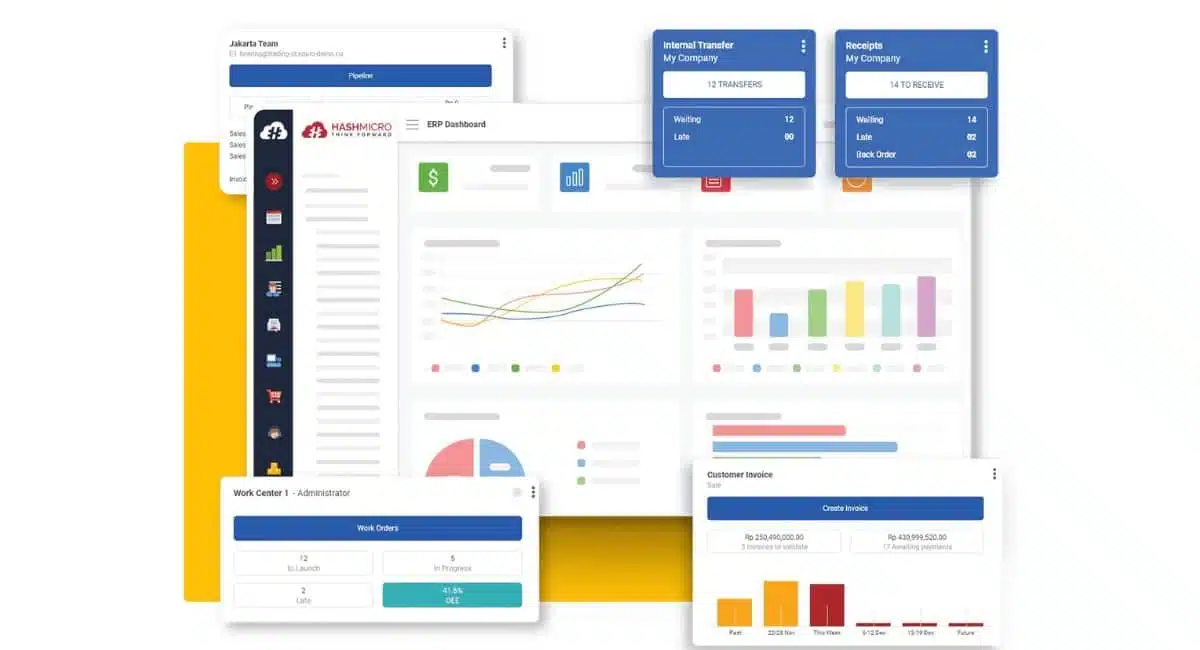A Warehouse Management System (WMS) is software that manages warehouse operations like inventory tracking, picking, and shipping, while Supply Chain Management (SCM) software oversees the entire flow of goods from suppliers to customers.
With software spending projected to hit $95 million by 2025, choosing the right system is more important than ever. HashMicro offers both SCM and WMS solutions to help businesses streamline logistics, improve visibility, and boost efficiency.
In this article, we’ll highlight the key differences between SCM and WMS and show how using both can optimize your supply chain. Ready to transform your operations? Book a free demo with HashMicro today!
Key Takeaways
|
Table of Contents

What is a WMS and SCM?
Managing inventory and logistics efficiently requires more than manual coordination. As businesses grow and operations become more complex, companies need structured systems to maintain visibility, control workflows, and align warehouse activities with broader supply chain strategies. Two key systems that support this objective are Warehouse Management Systems (WMS) and Supply Chain Management (SCM), each playing a distinct but interconnected role in daily operations.
Definiton of Warehouse Management System (WMS)
Warehouse Management System (WMS) is software that manages end-to-end warehouse operations, from receiving and storing goods to picking, packing, and shipping. It provides real-time visibility of inventory both in storage and in transit.
By automating key processes, a WMS improves efficiency, reduces errors, and saves time and money. This makes it essential for optimizing warehouse performance and maintaining smooth day-to-day operations.
In the Philippines, where businesses often handle diverse products, a WMS ensures precise stock levels and enhances customer satisfaction. Implementing a strong WMS supports business growth and helps companies adapt to changing market demands more effectively.
Definiton of Supply Chain Management?
Supply Chain Management (SCM) is a strategic approach to overseeing the end-to-end production and distribution process. It ensures that goods and financial resources flow seamlessly from the initial acquisition of raw materials to the final delivery of products.
SCM involves coordinating a wide range of activities, including supplier management, production oversight, and customer service, to ensure that each component of the supply chain operates efficiently and effectively.
By integrating these various functions, the SCM inventory management system aims to optimize overall supply chain performance and improve operational efficiency. In addition, SCM plays a vital role in managing inventory levels effectively.

Comparing WMS and SCM: Understanding Their Key Differences
After understanding the importance of both systems, let’s take a closer look at how they differ. Comparing WMS and SCM will help you see how each one contributes to smoother operations and how integrating them can maximize your supply chain efficiency.
| Role | WMS | CMS |
| Scope and Focus | Optimizes warehouse operations, including storage, inventory flow, and order fulfillment across locations. | Manages the full supply chain, from sourcing and production to distribution, linking suppliers to end customers. |
| Functionality | Handles warehouse operations like inventory management, workforce coordination, and order picking efficiency. | Organizes and manages the movement of goods and data across various stages of the supply chain. |
| Interconnectivity | Functions as a part of the larger SCM system, concentrating on warehouse operations. | Oversees high-level strategies like supplier selection and ensuring smooth end-to-end delivery. |
| Software complexity | Highly specialized and often needs integration with systems like TMS or ERP. | Provides wider functions, including procurement, production, and warehouse management. |
Types of Warehouse Management Systems
When considering Warehouse Management Systems (WMS), it’s essential to understand the different types available to suit various business needs. The primary distinctions are integrated versus standalone WMS and on-premise versus cloud-based WMS.
Integrated vs. Standalone WMS
| WMS Type | Description & Use Case |
|---|---|
| Integrated WMS | Integrated WMS works seamlessly with other business systems such as ERP, inventory, and order management. It enables real-time data sharing across departments, improves coordination, and provides end-to-end visibility. This setup is ideal for businesses that need warehouse operations aligned with overall business processes. |
| Standalone WMS | Standalone WMS operates independently and focuses on core warehouse functions such as inventory tracking, picking, packing, and order fulfillment. It suits businesses that need a dedicated warehouse tool without complex system integration. However, it may offer fewer capabilities compared to integrated solutions. |
On-Premise vs. Cloud-Based WMS
Understanding the differences between on-premise and cloud-based WMS is essential when selecting a solution that fits your operational needs and budget. The table below highlights the key distinctions to help you compare both deployment models more clearly.
| WMS Deployment Type | Description & Key Considerations |
|---|---|
| On-Premise WMS |
|
| Cloud-Based WMS |
|
Key Features of Warehouse Management System
Knowing the key features of a Warehouse Management System (WMS) is essential for companies to meet their warehouse management needs effectively. Understanding these functionalities allows businesses in the Philippines to customize their WMS to fit their specific operational requirements and boost efficiency.
Identifying the right features ensures that the chosen WMS supports the company’s objectives and streamlines warehouse operations. Below are the main features that every warehouse management must own:
- Inventory tracking and management: Real-time tracking of inventory levels, locations, and movements ensures accurate stock management and reduces the risk of overstock or stockouts.
- Order fulfillment and processing: Streamlined order picking, packing, and shipping processes to improve order accuracy and speed up delivery times.
- Automation and integration: Integration with other business systems (e.g., ERP, CRM) and automation technologies (e.g., barcode scanning, RFID) to enhance operational efficiency and reduce manual errors.
- Advanced reporting and analytics: Comprehensive reporting and analytics tools to monitor warehouse performance, identify trends, and support data-driven decision-making.
Before learning more about other excellent features for your complex business needs, you can start trying the software price calculation by clicking the banner below. Get to know your specific business needs with HashMicro.

Benefits of Using Warehouse Management Software
Before discussing WMS benefits in detail, it’s essential to understand how these systems can transform your warehouse operations. The following sections explore how wms software benefits can drive significant improvements and support your company’s growth.
1. Increased inventory accuracy
Stock management software enhances inventory accuracy by providing real-time tracking and automated updates. This reduces the risk of errors such as stockouts and overstocking, leading to more reliable inventory levels. Consequently, businesses can operate with greater confidence and efficiency.
2. Optimized warehouse space utilization
Inventory management tools help organize warehouse storage more effectively by maximizing available space. This efficient layout not only improves accessibility but also streamlines warehouse operations, resulting in smoother and more productive workflows. Better space utilization reduces wasted space and enhances overall operational efficiency.
3. Better supply chain management
An effective WMS integrates various supply chain functions, improving coordination and the flow of goods. It enables better logistics planning and execution, leading to a more responsive and agile supply chain. This integration helps businesses meet demand more accurately and efficiently.
4. Reduction in operational costs
Increased efficiency through a WMS reduces operational costs by minimizing waste and streamlining processes. This cost-saving effect improves the business’s financial health, thereby increasing profitability. Effective management translates to better resource allocation and lower overall expenses.
5. Efficient labor management
Automated warehouse operations simplify routine tasks and balance workloads more evenly among staff. This leads to lower labor costs and improved productivity by minimizing manual effort and reducing errors. Streamlined processes ensure that labor resources are utilized more effectively.
6. Advanced data analytics
Modern WMS solutions provide advanced data analytics that delivers valuable inventory and operational performance insights. This data-driven approach supports informed decision-making and strategic planning, helping businesses thrive in the competitive Philippine market. Leveraging these insights can drive growth and operational improvements.
7. Improved customer service
A robust WMS boosts customer satisfaction with enhanced order accuracy and delivery times. Efficient inventory management leads to fewer errors and quicker fulfillment, resulting in happier, more loyal customers. High-quality service strengthens customer relationships and encourages repeat business.
Key Factors to Consider Before Choosing the Right Warehouse Management Software
Selecting the right Warehouse Management Software (WMS) is crucial for optimizing warehouse operations and achieving business goals. To make an informed choice, it’s essential to consider various factors that align with your specific needs and operational requirements.
In the following section, we’ll explore critical considerations to guide you in selecting the most suitable WMS for your business.
- Identify your business needs: Clearly define your warehouse management requirements and objectives before selecting a WMS. Understanding your specific needs ensures that your chosen software effectively addresses your operational challenges and enhances efficiency.
- Scalability: Ensure the WMS can grow with your business, handling increased inventory volumes and evolving operational needs without requiring a complete system overhaul.
- Integration capabilities: Assess how well the WMS integrates with existing systems, like ERP and CRM software, to ensure smooth data flow and enhance overall efficiency.
- User-friendliness: Choose software with an intuitive interface and easy navigation to minimize the learning curve and boost productivity.
- Real-time tracking: Look for features that provide real-time inventory visibility and tracking to improve accuracy, reduce errors, and support better decision-making.
- Customizability and reporting: Evaluate the software’s ability to be customized to fit your business processes and the quality of reporting and analytics tools to gain actionable insights and optimize operations.
- Cost and support: Consider the total cost of ownership, including purchase, implementation, and maintenance, and ensure reliable customer support and training resources are available to facilitate smooth adoption and use.
HashMicro as a Comprehensive WMS and SCM Software Solution
HashMicro is a renowned ERP software provider in the Philippines. It offers comprehensive Warehouse Management System (WMS) and Supply Chain Management (SCM) solutions. These tools are designed to streamline and optimize various aspects of business operations.
Experience the full potential of HashMicro’s solutions by trying a free trial with our professional team. Discover how our advanced systems can transform your warehouse and supply chain management processes.
The following are the features of HashMicro’s comprehensive warehouse management system:
- Product Dimension Tracking: This feature tracks product dimensions such as size, weight, and volume. This ensures accurate inventory management.
- Location Dimension Management: This feature manages the dimensions of storage locations in the warehouse, including shelf size and capacity.
- Putaway Strategy Settings: This feature allows you to define how products should be stored in the warehouse based on factors like product type and movement frequency.
- Stock Optimizer per Warehouse: This feature helps optimize inventory management within each warehouse by analyzing data to reduce excess and shortage.
- Putaway Capacity Checking: This feature allows you to check the available storage capacity before placing new items. This prevents overloading and ensures the efficient use of warehouse space.
- Picking, Packing, Delivery 3-Step Route Warehousing: This feature provides a structured process for picking, packing, and delivering items with optimized routes.Warehouse Pallet Racking: Using this feature, you can maximize vertical and horizontal storage space with a racking system.
- Integrated with Barcode & QR Code: This feature uses barcode and QR code technology for faster and more accurate scanning and tracking of products.
- Warehouse Reporting: Using this feature, you can generate detailed reports on warehouse operations, such as inventory performance and process efficiency.
Conclusion
Understanding the differences between Warehouse Management Systems (WMS) and Supply Chain Management (SCM) is crucial for optimizing business operations. While WMS focuses on managing and streamlining warehouse functions, SCM encompasses the broader logistics and coordination of goods from suppliers to customers.
HashMicro’s Warehouse Management System is an excellent choice for achieving operational efficiency. With its advanced features and customizable options, HashMicro WMS is designed to enhance inventory management, improve accuracy, and streamline warehouse processes, ultimately supporting your business’s growth and success.
To experience the benefits firsthand, we invite you to try a free demo of HashMicro’s Warehouse Management Software. Explore how our solutions can transform your warehouse operations and drive greater efficiency in your business.

FAQ about Warehouse Management System
-
Is WMS part of Supply Chain?
Yes, a Warehouse Management System (WMS) is an integral part of the supply chain. It focuses on managing and optimizing warehouse operations, including inventory tracking, order fulfillment, and shipping processes.
-
What are the function of warehouse control system?
A Warehouse Control System (WCS) manages the real-time operations within a warehouse. It coordinates moving goods, order picking, and sorting activities, often integrating with automated systems like conveyors and robotics. The primary functions include optimizing workflow, ensuring accurate inventory counts, and improving order accuracy and processing speed.
-
What is the difference between inventory and WMS?
Inventory refers to the goods and materials a business holds for resale or production. A Warehouse Management System (WMS), on the other hand, is a software solution that manages and controls various warehouse operations, including inventory tracking, storage, and retrieval. While inventory is the physical stock, WMS provides the tools and processes to efficiently manage and optimize that stock within the warehouse.
-
What is CRM sales process?
The CRM sales process encompasses the series of steps that sales teams follow to convert prospects into customers using Customer Relationship Management (CRM) software. This process typically includes lead generation, qualification, engagement, proposal, negotiation, and closing. CRM systems help streamline these steps by providing tools for tracking interactions, managing customer data, and automating tasks.
-
How does CRM affect sales?
CRM significantly impacts sales by centralizing customer information, automating repetitive tasks, and providing valuable insights through data analytics. This leads to improved customer relationship management, more personalized interactions, and better follow-up on leads. Consequently, sales teams can work more efficiently, close deals faster, and enhance customer satisfaction, ultimately driving higher sales and revenue.























